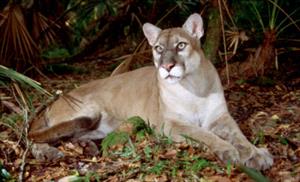Outdoor cats need particular care in areas with wild felids, particularly endangered species
Panther

Florida panther. Photo courtesy of U.S. Fish and Wildlife
The indoor vs outdoor cat debate never seems to end.
Some decry outdoor cats as the world’s most destructive “invasive species.”
- Some say that outdoor cats do what outdoor cats (and any other carnivores) do… they hunt to eat.
Cats kill large numbers of birds every year.
- So do lots of other things.
In an ideal world, we’d have no feral cats and all pet cats would live happily inside.
- We don’t live in that world.
I have one indoor cat (Finnegan) and two outdoor cats. They’re outdoor cats out of necessity. The first one (Rumple) was adopted through the Guelph Humane Society’s working cat adoption program. Basically, these are cats that are deemed unadoptable as house pets or that otherwise wouldn’t do well in a household situation. Rumple’s a major suck and might tolerate an indoor/outdoor lifestyle (although Finnegan would disagree with that notion). So, despite nominally being a barn cat, he spends his summers on our deck and winters in his heated house in the garage. Yes, he hunts (although probably not too much since he’s well fed). He’s vaccinated, dewormed, neutered and microchipped. He has an ecological impact but it’s pretty minimal in the grand scheme. The other outdoor cat (Alice) was a wayward feral female cat that Rumple adopted. She started hanging around, Rumple took her in, and she had a litter of kittens shortly thereafter. They were adopted into homes, she was spayed, vaccinated, dewormed and microchipped and she’s getting fat, living the good (outdoor) life. We can pet her on her terms but there’s no way she’d tolerate an indoor lifestyle.
Yes, I realize they have an ecological impact. Yes, I realize (and have constant concern) that there are risks from cars, coyotes and other critters. However, this is the lifestyle that suits them and it’s a balance I accept.
Anyway, that’s a very long and somewhat philosophical introduction to the topic of this post: introduction of feline leukemia virus (FeLV) into endangered Florida panthers. A recent paper in Emerging Infectious Diseases (Chiu et al. 2018) describes multiple introductions of this virus into the panther population, which is a significant concern for a species with such small numbers.
Feline leukemia virus is an important cause of disease in domestic cats and periodically spills over into wild felids (members of the cat family), sometimes with high rates of illness and death. In Florida, an outbreak of FeLV was identified in panthers between 2001 and 2004. Between 2004 and 2010, FeLV was not identified in any of 125 panthers tested in the state. However, since 2010, 6 panthers that were found dead tested positive. One of those might have died because of the virus. The other 5 were killed on the road but were infected. It may seem like a small number, but it’s a relevant number in a such a small, endangered population. It’s also impossible to monitor and test all animals, so 6 infected animals is an under-estimate of the prevalence in the whole population.
Genetic testing of the virus was used to sort out why this was happening, and to determine how linked the infections were. The viruses from the 2001-2004 and 2010-2016 outbreaks were distinct, indicating separate introductions into the panther population. Presumably, panthers were infected by cats on at least two different occasions, likely when domestic cats were preyed on by panthers.
Transfer of FeLV from cats to panthers is probably a rare event, considering the number of cats that are encountered (it’s been estimated that “domestic” cats account for approximately 5 percent of the panther diet). However, as we know with many diseases and many species, all it takes is a single encounter for a new pathogen to establish itself in the population.
My take home messages from all this are:
- It’s better for domestic cats to be indoors if they tolerate it. It reduces the risk to them and wildlife.
- Not all cats can live solely (or partly) indoors.
- We should optimize the health of cats that go outdoors and make sure that the best preventive medicine program is in place for them, to reduce the risk to them and the risk of them passing something on to other cats or other species.
- Cats known to be harbouring important pathogens such as FeLV and FIV should be kept inside if at all possible.
- Owners of cats that go outside should talk to their veterinarian about risks (to the cat and others) of being outside and determine an appropriate preventive medicine program. (They should absolutely be spayed or neutered.)
- Particular care must be taken in areas where there are wild felids, particularly endangered species.